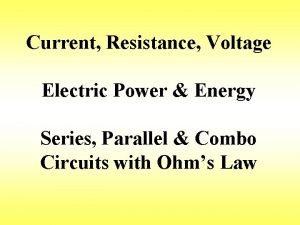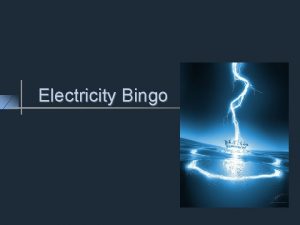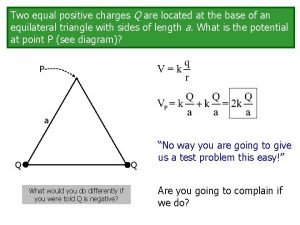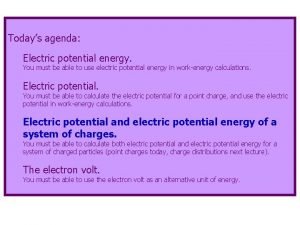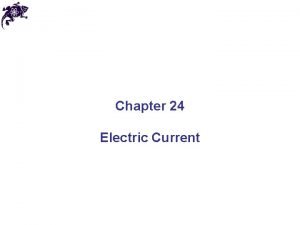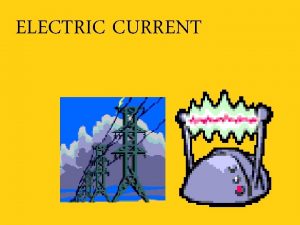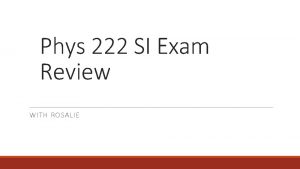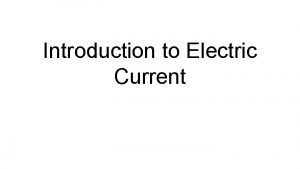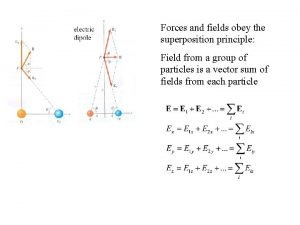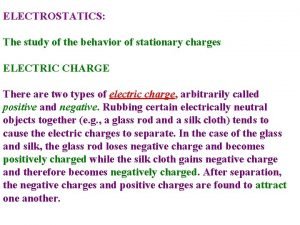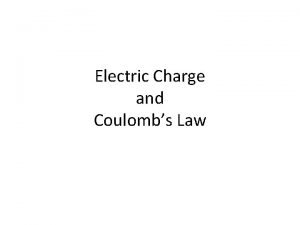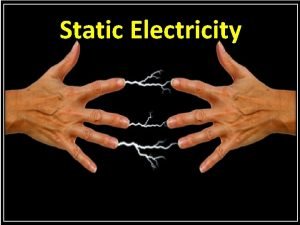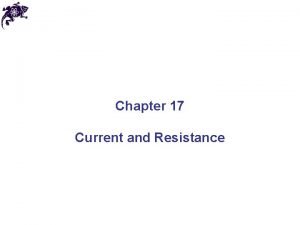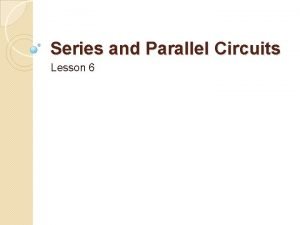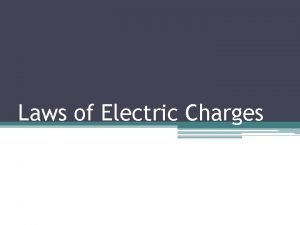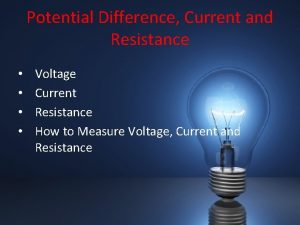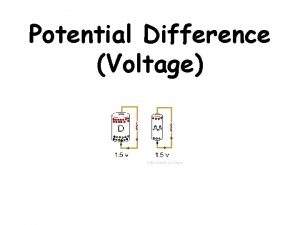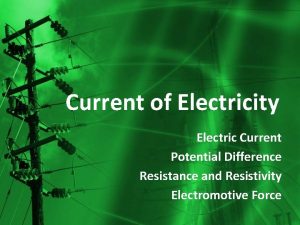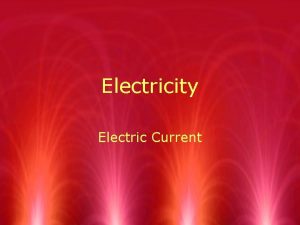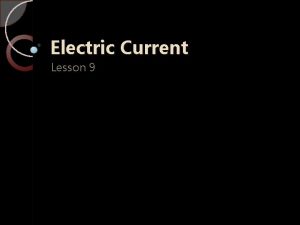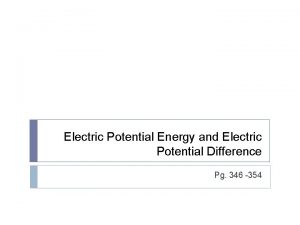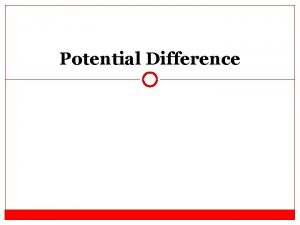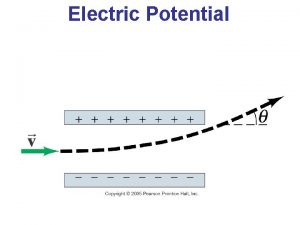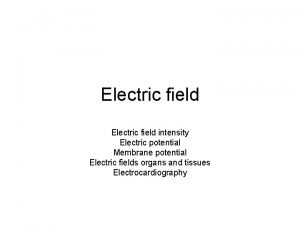Electric Current and Resistance Physics Potential Difference Charges









































- Slides: 41

Electric Current and Resistance Physics

Potential Difference ® Charges can “lose” potential energy by moving from a location at high potential (voltage) to a location at low potential. ® Charges will continue to move as long as the potential difference (voltage) is maintained.

Potential Difference =Voltage=EMF In a battery, a series of chemical reactions occur in which electrons are transferred from one terminal to another. There is a potential difference (voltage) between these poles. The maximum potential difference a power source can have is called the electromotive force or (EMF), e. The term isn't actually a force, simply the amount of energy per charge (J/C or V)

Current ® A sustained flow of electric charge past a point is called an electric current. ® Specifically, electric current is the rate that electric charge passes a point, so Current = or I = q/t Charge time

Measuring Current ® If 1 Coulomb of charge (6. 25 x 1018 electrons) passes a point each second, the current is 1 Ampere. ® So, 1 Ampere = 1 Coulomb/sec

Ampere (for Andre’ Ampere) Usually called an amp Open Circuit – break in the circuit, no current flow

Voltage Source ® A battery or electrical outlet is a source of electric potential or voltage - not charge. ® The electrons that move in a conductor are supplied by the conductor - not the voltage source. ® The net charge on a current-carrying conductor is zero.

Electromotive Force ® An old-fashioned term for electric potential or voltage is “electromotive force” or “emf”.

Electrical Resistance ® Most materials offer some resistance to the flow of electric charges through them. This is called electrical resistance.

Resistance (R) – is defined as the restriction of electron flow. It is due to interactions that occur at the atomic scale. For example, as electron move through a conductor they are attracted to the protons on the nucleus of the conductor itself. This attraction doesn’t stop the electrons, just slows them down a bit and causes the system to waste energy. The unit for resistance is the OHM, W

Resistance ® Resistance of a conductor depends on: ® Material - Gold is best ® Length - longer conductors have more resistance. ® Cross section - thick wires have less resistance than thin wires ® Temperature - higher temperature means more resistance for most conductors

Ohm’s Law ® For many conductors, current depends on: ® Voltage - more voltage, more current ® Current is proportional to voltage ® Resistance - more resistance, less current ® Current is inversely proportional to resistance

Ohms’ Law ® In symbols: ®V = IR V I R

George Simon Ohm (1787 -1854) The actual values depend on the resistance of the conductor Called Ohm’s Law R – resistance measured in Ohms (W)

Ohm’s Law “The voltage (potential difference, emf) is directly related to the current, when the resistance is constant” e s ce n ta R= Since R=DV/I, the resistance is the SLOPE of a DV vs. I graph i s re = s p lo

Direct Current ® If the voltage is maintained between two points in a circuit, charge will flow in one direction - from high to low potential. This is called direct current (DC) ® Battery-powered circuits are dc circuits.

Alternating Current ® If the high & low voltage terminals switch locations periodically, the current will flow “back and forth” in the circuit. This is called alternating current (AC). ® Circuits powered by electrical outlets are AC circuits.

AC in the US ® In the US, current changes direction 120 times per second, for a frequency of 60 cycles per second or 60 Hertz. ® Normal outlet voltage in the US is 110120 volts, although some large household appliances run on 220 -240 volts.

Converting AC to DC ® AC is converted to DC using devices called diodes, which allow charges to move in only 1 direction.

Speed of Electrons ® Electrons in a circuit do not move quickly - they actually “drift” at about 1 mm/s. ® It is the electric field that moves quickly - at about the speed of light - through the circuit and carries the energy.

Electrical POWER We have already learned that POWER is the rate at which work (energy) is done. Circuits that are a prime example of this as batteries only last for a certain amount of time AND we get charged an energy bill each month based on the amount of energy we used over the course of a month…aka POWER.

POWER It is interesting to see how certain electrical variables can be used to get POWER. Let’s take Voltage and Current for example.

Other useful power formulas These formulas can also be used! They are simply derivations of the POWER formula with different versions of Ohm's law substituted in.

Ways to Wire Circuits There are 2 basic ways to wire a circuit. Keep in mind that a resistor could be ANYTHING ( bulb, toaster, ceramic material…etc) Series – One after another Parallel – between a set of junctions and parallel to each other

Schematic Symbols Before you begin to understand circuits you need to be able to draw what they look like using a set of standard symbols understood anywhere in the world For the battery symbol, the LONG line is considered to be the POSITIVE terminal and the SHORT line , NEGATIVE. The VOLTMETER and AMMETER are special devices you place IN or AROUND the circuit to measure the VOLTAGE and CURRENT.

Closing the switch establishes a potential difference (voltage) and an electric field in the circuit. ® Electrons flow in a net direction away from the (-) terminal. Low Potential High Potential

Conventional Current ® By tradition, direction in which “positive charges” would flow. ® Direction is opposite of electron flow.

The Voltmeter and Ammeter Current goes THROUGH the ammeter The voltmeter and ammeter cannot be just placed anywhere in the circuit. They must be used according to their DEFINITION. Since a voltmeter measures voltage or POTENTIAL DIFFERENCE it must be placed ACROSS the device you want to measure. That way you can measure the CHANGE on either side of the device. Voltmeter is drawn ACROSS the resisto Since the ammeter measures the current or FLOW it must be placed in such a way as the charges go THROUGH the device.

Voltmeter ® Measures the voltage between two points in an electric circuit. ® Must be connected in parallel.

Ammeter ® Measures electric current. ® Must be placed in series.

Simple Circuit When you are drawing a circuit it may be a wise thing to start by drawing the battery first, then follow along the loop (closed) starting with positive and drawing what you see.

Series Circuit In in series circuit, the resistors are wired one after another. Since they are all part of the SAME LOOP they each experience the SAME AMOUNT of current. In figure, however, you see that they all exist BETWEEN the terminals of the battery, meaning they SHARE the potential (voltage).

Series Circuit As the current goes through the circuit, the charges must USE ENERGY to get through the resistor. So each individual resistor will get its own individual potential voltage). We call this VOLTAGE DROP. Note: They may use the terms “effective” or “equivalent” to mean TOTAL!

Example A series circuit is shown to the left. a) What is the total resistance? R(series) = 1 + 2 + 3 = 6 W b) What is the total current? DV=IR 12=I(6) I = 2 A What is the current across EACH resistor? They EACH get 2 amps! d) What is the voltage drop across each resistor? ( Apply Ohm's law to each resistor separately) c) V 1 W=(2)(1)= 2 V V 3 W=(2)(3)= 6 V V 2 W=(2)(2)= 4 V Notice that the individual VOLTAGE DROPS add up to the TOTA

Parallel Circuit In a parallel circuit, we have multiple loops. So the current splits up among the loops with the individual loop currents adding to the total current It is important to understand that parallel circuits will all have some position where the current splits and comes back together. We call these JUNCTIONS. The current going IN to a junction will always equal the current going OUT of a junction. Junctions

Parallel Circuit. Notice that the JUNCTIONS both touch the POSTIVE and NEGATIVE terminals of the battery. That means you have the SAME potential difference down EACH individual branch of the parallel circuit. This means that the individual voltages drops are equal. DV This junction touches the POSITIVE terminal This junction touches the NEGATIVE terminal

Example To the left is an example of a parallel circuit. a) What is the total resistance? 2. 20 W b) What is the total current? 3. 64 A c) What is the voltage across EACH resistor? 8 V each! d) What is the current drop across each resistor? (Apply Ohm's law to each resistor separately) 1. 6 A 1. 14 A 0. 90 A Notice that the individual currents ADD to the total.

Compound (Complex) Circuits Many times you will have series and parallel in the SAME circuit. Solve this type of circuit from the inside out. WHAT IS THE TOTAL RESISTANCE?

Compound (Complex) Circuits Suppose the potential difference (voltage) is equal to 120 V. What is the total current? 1. 06 A What is the VOLTAGE DROP across the 80 W resistor? 84. 8 V

Compound (Complex) Circuits What is the current across the 100 W and 50 W resistor? What is the VOLTAGE DROP across the 100 W and 50 W resistor? 0. 352 A Add to 1. 06 A 35. 2 V Each! 0. 704 A

The End ®
 Electric potential energy definition
Electric potential energy definition Current potential difference and resistance
Current potential difference and resistance Define electric potential and potential difference.
Define electric potential and potential difference. Volts to ev
Volts to ev Electric potential inside non conducting sphere
Electric potential inside non conducting sphere Potential and potential difference
Potential and potential difference Electric charges and electric forces lesson outline
Electric charges and electric forces lesson outline R total parallel circuit
R total parallel circuit V = pe/q
V = pe/q Equation for electric potential energy
Equation for electric potential energy Electric field and electric potential
Electric field and electric potential Like charges blank and opposite charges blank
Like charges blank and opposite charges blank Ap physics c electric potential
Ap physics c electric potential Electricity
Electricity Difference between sales potential and market potential
Difference between sales potential and market potential Potential and potential difference
Potential and potential difference Electric potential difference
Electric potential difference Constant rate filtration equation
Constant rate filtration equation Ignoring friction air resistance and electrical resistance
Ignoring friction air resistance and electrical resistance Potential energy of two equal positive charges
Potential energy of two equal positive charges Potential energy of system of charges
Potential energy of system of charges Potential energy between two charges
Potential energy between two charges Current is the rate at which charges move through a(n)
Current is the rate at which charges move through a(n) Electric current is the movement of
Electric current is the movement of The figure shows three electric charges labeled
The figure shows three electric charges labeled What is the continuous flow of electric charge?
What is the continuous flow of electric charge? Superposition principle is obeyed by
Superposition principle is obeyed by Induction charging physics
Induction charging physics Origin of charge
Origin of charge Electric charges of the same sign
Electric charges of the same sign The law of charges
The law of charges What is coulomb's law
What is coulomb's law The buildup of electric charges on an object
The buildup of electric charges on an object Difference between potential difference and emf
Difference between potential difference and emf Biotic potential in ecology
Biotic potential in ecology Difference between population and community
Difference between population and community Biotic potential and environmental resistance
Biotic potential and environmental resistance 17-1 current and resistance answers
17-1 current and resistance answers Lesson 6 current voltage and resistance in a circuit
Lesson 6 current voltage and resistance in a circuit Current resistance and electromotive force
Current resistance and electromotive force Graded potential vs action potential
Graded potential vs action potential Water potential definition biology
Water potential definition biology







